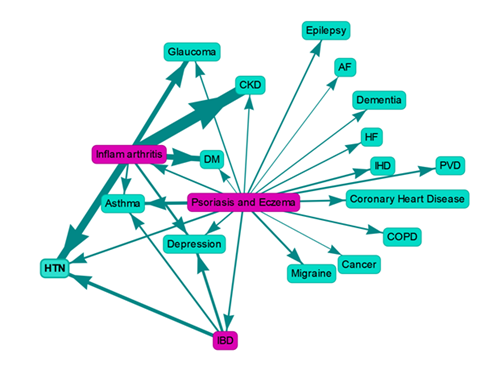Some early findings & Publications
Background
The InflAIM project has been running since February 2021.
We have been working on data from:
- NOAR – the Norfolk Arthritis Register -a cohort of patients diagnosed with inflammatory arthritis
- UK Biobank – a national volunteer research cohort
- ECLIPSE – GP electronic health records
- THIN – The Health Improvement Network database, a primary care dataset
We have been looking at patterns in the data to seek evidence of the relationship betweenthe development of multimorbidity (defined as two or more chronic conditions) and chronic inflammation. We have also been testing how well our statistical and AI methods work, and how they might need to be modified to work on large datasets.
In NOAR:
- A total of 4,674 patients were observed between 2 to 15 times over 25 years
- There were 33,356 records in total
- There were 269 unique combinations of long term conditions
Our preliminary analysis showed that:
- Age of disease onset rather than age alone promotes multimorbidity, suggesting that inflammation might be a trigger to accelerated multimorbidity.
- Obesity increases the risk of progression of multimorbidity
- Drugs used to reduce inflammation in arthritis also reduce the rate of accumulation of multimorbidity, suggesting that they might have help in managing multimorbidity in other settings.
In UK Biobank:
- There were 588,891 records with 44,602 unique combinations of long term conditions
- Looking over a 25 year span, the rate at which disease conditions accumulated appeared to fall into three distinct classes or trajectories

- The level of the inflammatory marker CRP in the blood at baseline predicted the rate of progression of multimorbidity over time: higher baseline levels led to a faster rate of accumulation of long term conditions

In Eclipse:
- We looked at 1 million anonymised records from people from Norfolk
- Our preliminary analysis shows distinct diseases that cluster with inflammatory conditions
- Depression, cardiovascular disease, and dementia all appeared to be linked through inflammation

In THIN:
- We looked at 3,729,325 records from 110,243 patients.
- There were 50,784 unique combinations of multimorbidity.
- We found that statins (lipid lowering drugs with anti-inflammatory effects) reduce the rate that multimorbidity progressed over time.
- Multimorbidity progression was also lower in people who were born later, indicating that healthy life expectancy has been improving.
Some lessons
- Our early findings lend support to the notion that inflammation drives multimorbidity
- In the short time the project has been running we have already identified new pathways that might explain how particular combinations of diseases develop over time and how they might be controlled or prevented.
- We have identified how standard statistical models need to be modified to cope with multiple combinations of conditions in big datasets and are developing AI methods to help handle this level of complexity
Technical summaries of the work to date can be obtained by contacting the team.
